
Bita Vakili and the $40,000 “Oil Highway” at Christie’s Dubai / Environmental Warnings
This untitled work by Bita Vakili, known as “Oil Highway,” was auctioned for $40,000 at Christie’s Dubai on October 21, 2014. Many art theorists praised the piece’s aesthetic value and its wide horizontal format, and commended the painter’s environmental awareness.
ArtDayMe : Azadeh Jafarian : The untitled work by Bita Vakili, known as “Oil Highway,” created using mixed media on canvas in a strikingly large format (300 × 111 cm), sold for $40,000 at Christie’s Dubai on October 21, 2014.
Aesthetically, the work’s dynamic chaos immediately impacts the viewer.

Swirling forms, stark contrasts between dark and light tones, and complex layering create an aesthetic that is both mesmerizing and unsettling.
The horizontal, landscape-oriented frame enhances a sense of vast, sprawling dispersion—almost like an aerial map, but condensed into something far more emotional and unstable.
The composition draws the eye along a dark central mass, as if following a river, oil spill, or highway cutting through a devastated urban landscape.

The richness of texture adds tangible beauty—dense, tactile, and almost geological.
Vakili’s technical approach is extraordinarily complex and defining here: through the artist’s combination of materials and collage, the surface is constructed from layers of substance, not just paint—creating real, physical texture. Collage elements like staples lend it the feel of an “assembled history.”
The fluid abstraction throughout the piece is serious; the central black form evokes the organic and uncontrollable nature of oil.

The surrounding “urban” textures are sharp, mechanical, and structured—revealing the painter’s obsessive precision and the importance of repetition in constructing each component—while the oil form itself is chaotic and destructive, executed with freer, more instinctive methods.
Bita Vakili’s color palette is conceptually precise and unique; dominant blacks and deep blues overwhelm the eye; the oil is rendered in heavy, suffocating colors—black, navy, hints of toxic green and purple—symbolizing pollution, destruction, and greed, to the point the viewer might feel compelled to cough.
The surrounding areas in dusty beige and pale ochre recall dry, eroded land or desert.
Metallics and vibrant accents appear in the surrounding urban zones—flashes of red, purple, and metallic gleam—as if the city is artificially vibrant yet environmentally doomed.

The tension between organic (spilled materials) and synthetic (engineered structures) is amplified by these color contrasts.
From a symbolic standpoint, “Oil Highway” is rich with layered meanings:
From an environmental lens, the painting appears as a dry, dying landscape corrupted by the path of oil. It alludes to environmental degradation—particularly in oil-dependent regions.
Urban sprawl and consumerism form another clear thread: this is a dense, overpopulated, uninhabitable city—perhaps a commentary on how oil wealth leads to unchecked urbanization, inequality, and ecological disaster.
At the same time, the piece cuts into deeper social issues: globalization, profit-driven expansion with no regard for human or environmental well-being, convoluted urban structures, anxiety, confusion, and isolation—emotions reflecting life in sprawling, unplanned megacities worldwide.
Vakili’s use of mixed media, collage, and her critical stance align her with postmodern methods.
Conceptually, the work fits within the tradition of environmentally conscious art—think of artists like Olafur Eliasson or Edward Burtynsky, though Vakili’s tone is far more emotional and less clinical.
There is a growing body of work from Middle Eastern artists addressing the intersections of oil, war, identity, and modernity—and Vakili’s painting makes a powerful contribution to this discourse.

Bita Vakili’s “Oil Highway” is not just a painting—it is a visual indictment, a cultural elegy, and an emotional landscape.
Through masterful technique, complex layering, and deep awareness of both personal and collective histories, Vakili has created a work that is both beautiful and deeply disturbing.
It is worth noting that Bita Vakili has started the new calendar year by showcasing her works at two art fairs in Frankfurt and Moscow.
Bita Vakili has six noteworthy sales at Christie's.
Bita Vakili, who began 2025 by exhibiting her work at two art fairs in Frankfurt and Moscow, has six noteworthy sales at Christie's.
Apart from the record-breaking $45,000 sale of "Dreaming New York" on April 18, 2012, one of Vakili's nameless works sold for $40,000 on October 21, 2014, and another untitled piece was purchased for $35,000 in October 2011. Furthermore, she sold her artwork "This Is Me" for $31,000 in October 2010. Meanwhile, on April 27, 2010 and April 2011, two of her unnamed paintings sold for $25,000 and $26,000, respectively.
Vakili's artworks have been featured in ten editions of the Tehran Auction so far. At the 20th edition of the art event in July, a three-panel piece from the collection "The Garden of History" sold for $130,000, setting a new record for her.

Vakili's paintings are held by prestigious institutions such as Bank Pasargad, Tourism Bank, and the Raha Gallery's Collection , the Farjam Foundation of Dubai, in addition to well-known Iranian collectors like Professor Firouz Naderi and Jalil Khosrowdshahi.

LEAVE A RELPY